Medium early gooseberry variety with high winter hardiness "Hinnonmaki Green"
The gooseberry was and remains one of the most popular berries among the owners of the sites. Gradually, old unproductive varieties are being replaced by modern ones with improved agronomic characteristics and a more pronounced taste. Hinnonmaki Green is one of the representatives of the culture, which is worth paying attention to both novice gardeners and experienced ones.
The content of the article
Features of the variety
Hinnonmaki Green is originally from Finland and zoned specifically for the cold European climate.
History of origin and distribution
In the middle of the last century, in front of Finnish scientists the task was set to bring a new version of the culture, fundamentally different from others in unpretentiousness and yield... The work was crowned with success - the Hinnonmaki variety appeared.
Interesting! But the scientists went further and continued crossing to get bushes with different colors of berries and other varietal characteristics. The series includes the popular Hinnonmaki Red (Roth), Yellow, Gelb and Green. The latter is distinguished by its green fruits.
Characteristics and description of the bushes
This is a tall plant with an early ripening period.... The usual height is 1-1.2 m, but in an ideal place and with good care it can grow up to 2 m. The crown is spherical and compact, the branches are spiky, slightly spreading, but grow densely. The bark is dark brown, flakes off with scales.
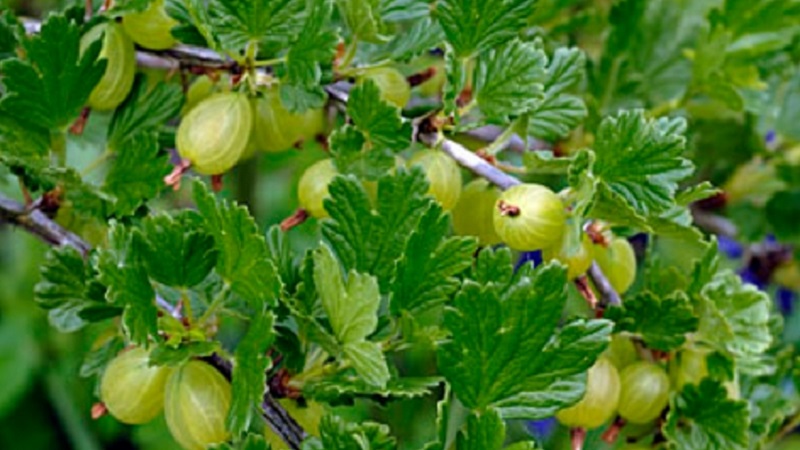
Dark green foliage, three to five lobed with slight pubescence... Flowers of a pale yellow color appear in May from the axils of the leaves one by one or 2-3 pieces.
Resistant to temperatures
Hinnonmaki Green is extremely hardy... Since the harsh North European climate was taken into account when breeding, it calmly tolerates a cold snap down to -30 ° C. In more extreme conditions, bushes require complete shelter for the winter.
Moisture and drought resistance
Gooseberries tolerate dry spells well and do not die without moisture... Water is required during the formation and pouring of the fruit. If it is not enough, the bush will throw off some of the ovaries. The remaining berries will be small and sour.
Disease and pest resistance
The variety is highly resistant to diseases and pests... To a greater extent, the immune system is formed against mildew and powdery mildew. Pests are affected when they spread throughout the site.
Characteristics and description of fruits
Berries are large, drop-shaped, weighing 4 g... The color is green with an olive tint, dark veins inside. Fruits are juicy with a delicate aroma, sweet and sour taste. The tasters give the variety an assessment of 4.7 points. The berries are prone to shedding, but the skin does not crack.
Hinnonmaki Green gooseberry bears fruit in the third year after planting... Productivity is stable, 4-7 kg per bush per season. Harvesting begins in the first half of July and continues until mid-August.
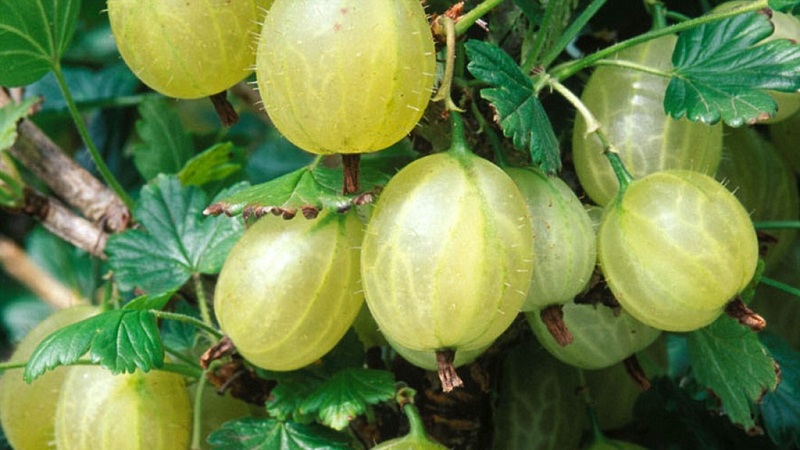
Application area
Berries are plucked with stalks to extend shelf life... To preserve their presentation, they are scattered on a tray in a thin layer and stored in a refrigerator or basement.The latter option requires a temperature not higher than + 3 ° C. In such conditions, the crop does not deteriorate up to 60 days. If closed containers are used, the shelf life is extended to 3 months.
Gooseberries are consumed fresh, used for toppings for pies and fruit desserts. Also, the fruits are used to make juices and wine.
Other gooseberry varieties:
Mid-early green gooseberry variety "Malachite"
Advantages and disadvantages compared to other varieties and hybrids
The variety was appreciated by professionals and amateurs for a number of advantages.:
- distinctive frost resistance;
- does not require constant attention in terms of watering and feeding;
- productivity is above average;
- berries with high taste characteristics;
- accepted on the trunk;
- resistance to many diseases inherent in the culture.
The disadvantages include a large number of thorns and shedding of ripe berries.
Growing technology
The correct choice of a seedling and adherence to agricultural techniques when planting give a good start for the successful development of the bush.
Optimal conditions
A plot is prepared under the gooseberry that meets the following conditions:
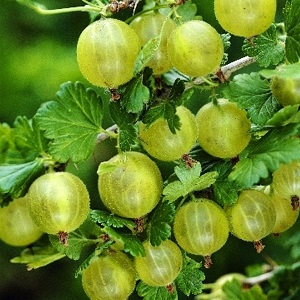 Constant illumination throughout the day. In a darkened place, the bush begins to ache, the yield and quality of the fruit decreases.
Constant illumination throughout the day. In a darkened place, the bush begins to ache, the yield and quality of the fruit decreases.- There is protection from the north winds.
- The site is a plain or high ground with a low water table. Damp soils and spring floods will lead to the death of the bush.
Gooseberries should not be planted next to and after raspberries and currants... The land in this place is already depleted, and the diseases and pests of crops are the same.
Terms and rules of landing
In regions with severe, long winters, gooseberries are planted only in spring.... Usually this time falls in the middle - end of April, when the snow has melted, and the surface layer of the earth has warmed up and saturated with moisture.
In temperate and warm climates planted in autumn and in spring... In each case, take into account that the minimum suitable temperature for survival is + 4 ... + 6 ° C. Choose a cloudy, windless day for work.
Sapling selection
When buying, pay attention to the condition of the root system and shoots... Choose a quality seedling 2-3 years old with flexible branches without damage. The buds and bark are alive, without spots, at least three basal shoots.
The bush in the container is removed and inspected. Healthy roots are white, without signs of dryness, tightly intertwined with an earthen ball.
Site preparation
2-3 weeks before disembarkation, a place is prepared according to the instructions:
- pull out weeds with roots;
- for 1 sq. m scatter a bucket of humus and 30 g of phosphorus-potassium fertilizer;
- dug to a depth of 30-35 cm;
- make holes 60 cm deep and 40-50 cm in diameter;
- drainage from rubble or expanded clay is placed on the bottom;
- the pit is half covered with earth and watered.
The variety prefers medium acid soil (pH 5.5-5.6). Clay is loosened with sand, black soil is added to the sandy one.
Landing technology
Before planting, the seedling is kept for 30-40 minutes in water or Kornevin solution. Further:
- a mound is formed in the middle of the hole, a bush is placed with a slight slope and the roots are straightened;
- fall asleep with earth so that the neck goes 5-7 cm below the surface level;
- compacted to avoid voids;
- a roller is made from the remains of the soil around the bush;
- watered.
Further care
Gooseberries do not need constant attention. All the main activities are reduced to rare feeding and watering, pruning and processing for the purpose of prevention infections and pests.
 The first time they water once a week, if there is no rain. In just a season, they do the moisture charge three times:
The first time they water once a week, if there is no rain. In just a season, they do the moisture charge three times:
- in the phase of flowering and formation of ovaries;
- at the beginning of fruit ripening;
- in preparation for winter.
Water is poured under the bush to the root zone.
Important! Avoid contact with leaves, otherwise drops and sun will cause burns.
The earth is loosened when it dries, mulch if desired.
If the site was initially well filled with nutrients, auxiliary feeding is required only for 2-3 years. In the spring, it is watered with a solution of nitrogen-containing fertilizer, mulched with a mixture of half a bucket of humus and 0.5 liters of ash.
In autumn processing scattered under the bush 2 tbsp. l. superphosphate and dug up with the formation inversion.
Pruning
Pruning aims to rejuvenate and increase yields... It also provides prevention of infections and improves airflow through the branches. The work is carried out in the spring before bud break or in the fall two months before frost. Remove:
- long shoots extending beyond the crown, leaving 5-7 buds;
- broken, sick and damaged are cut out at the root;
- old branches.
Wounds must be lubricated with garden varnish... From young shoots, 5-6 pieces are left so that they grow evenly along the bush in all directions.
Possible problems, diseases, pests
Disease outbreaks and insect pests are promoted by improper care or its complete absence. Such problems include too shady place, excess moisture, non-disinfected cuts during pruning.
Potential fungal pathogens include anthracnose, gray rot, rust goblet, white spot. If signs are found, diseased shoots are urgently cut out and burned. Before or after flowering and fruiting, they are sprayed with the preparations Topaz, HOM, Ridomil, Skor.
Of pests more often appear aphid, spider mite, sawfly, moth. At an early stage, treatment with soapy water or onion broth helps. In case of serious damage use the insecticides "Karbofos", "Aktara", "Inta-Vir".
Wintering
For a safe wintering, gooseberries are watered abundantly and the root zone is mulched any organic material. For insurance in case of little snow, they are additionally covered with straw.
In the middle lane, no cover is required if do not promise frosts below -30 ° C. In more severe conditions, snow is thrown onto the bush, and the root zone is trampled.
Reproduction
Vegetative methods are used in reproduction.... So varietal characteristics are preserved without loss of quality. Methods:
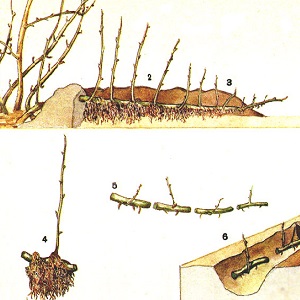 Layers - rooting of the shoot. In the spring, a healthy lower branch is selected, pinned to the ground with a bracket and sprinkled with earth, leaving 3-4 buds on the surface. They water it all summer, long drying cannot be allowed. In the fall, they are cut off from the mother bush and planted in a permanent place.
Layers - rooting of the shoot. In the spring, a healthy lower branch is selected, pinned to the ground with a bracket and sprinkled with earth, leaving 3-4 buds on the surface. They water it all summer, long drying cannot be allowed. In the fall, they are cut off from the mother bush and planted in a permanent place.- Division - the way is simple and fast. An adult bush is divided into parts so that each has 2-3 shoots, and planted as usual.
- Cuttings... An adult branch is cut into pieces 15-20 cm long with 3-4 buds each. Cuttings are buried in a box with soil by two-thirds, watered and covered with foil to create a greenhouse. Periodically ventilate and moisturize. When sprouts with several leaves appear, they are transplanted into the holes.
Features of cultivation depending on the region
The variety adapts easily to cold climates, therefore it is suitable for the middle zone, the Non-Black Earth Region and Siberia. For areas with constant frost, the difference is preparation for winter. The crown is wrapped with covering material, burlap, the roots are insulated with a thick layer of spruce branches.
In the southern regions, the variety is easy to cultivate., as it easily tolerates heat and drought.
Pollinating varieties
Hinnonmaki Green is a self-fertile variety... It is pollinated by bees and bumblebees.
Reviews of summer residents
Gardeners have long tasted the variety, they speak about it neutrally or positively.
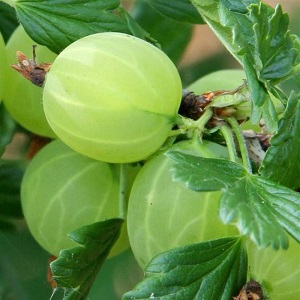 Galina, Moscow region: “I have harvested Hinnonmaki Green for the first time this season. The berries are completely green, not the largest, but I like the taste. If this continues, I will purchase other varieties for the collection. ".
Galina, Moscow region: “I have harvested Hinnonmaki Green for the first time this season. The berries are completely green, not the largest, but I like the taste. If this continues, I will purchase other varieties for the collection. ".
Victor, Ryazan: “The Finnish Hinnonmaki Green turned out to be not the highest yield, and there are a lot of thorns. Taste with a honey tint, berries are among the first to ripen and are eaten quickly.The bush is a little higher than a meter, it is growing in the 6th year, it made support immediately upon planting. ".
Conclusion
Hinnonmaki Green gooseberry meets modern requirements. Due to its unpretentiousness and endurance, it is cultivated in most climatic zones. Care is reduced to periodic watering, top dressing and crown formation. Prevention of diseases and pests is required, vegetative reproduction.